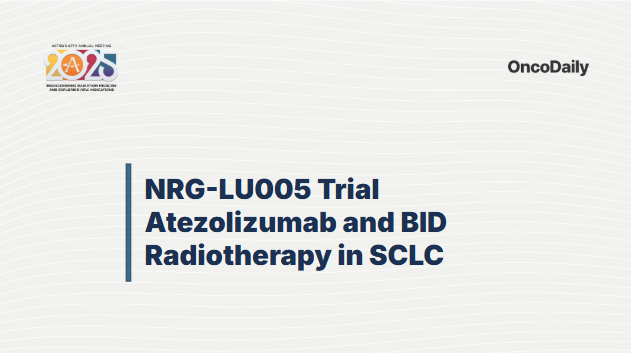The NRG-LU005 Phase III randomized trial is among the most comprehensive studies evaluating chemoradiation with or without immunotherapy in limited-stage small cell lung cancer (LS-SCLC). While earlier reports from this trial demonstrated no overall survival (OS) benefit with the addition of atezolizumab, a PD-L1 inhibitor, to standard concurrent chemoradiotherapy (CRT), it revealed a notable survival advantage for patients treated with twice-daily (BID) versus once-daily (QD) radiotherapy—35.4 months versus 28.3 months median OS, respectively.
Given the aggressive nature of SCLC and the intensity of combined-modality therapy, understanding the long-term patient-reported outcomes (PROs) is essential to balance efficacy with tolerability. This planned analysis of NRG-LU005 investigated how treatment modality, radiotherapy schedule, and immunotherapy integration affect quality of life (QOL), fatigue, and functional well-being over time.
Methods
A total of 544 patients with limited-stage SCLC were enrolled and randomized to receive standard CRT consisting of platinum/etoposide every 3 weeks for 4 cycles, combined with thoracic radiotherapy (either 45 Gy BID or 66 Gy QD starting in cycle 2). Patients in the experimental arm received atezolizumab every 3 weeks for up to one year, beginning concurrently with cycle 2 of chemotherapy.
Stratification factors included RT schedule (BID vs QD), chemotherapy type (cisplatin vs carboplatin), sex, and ECOG performance status (PS).Validated PRO instruments were employed to assess different aspects of health-related quality of life:
- FACT-TOI (Functional Assessment of Cancer Therapy – Trial Outcome Index) for general well-being and symptom burden.
- EQ-5D-5L, used to derive Quality-Adjusted Survival (QAS).
- PROMIS-Fatigue, to measure treatment-related fatigue.
PROs were collected at baseline, end of CRT, and 3, 6, 15, and 21 months after CRT.
A clinically meaningful decline (CMD) in FACT-TOI was defined as a ≥5-point decrease from baseline.
Multivariable logistic regression analyses adjusted for treatment arm, stratification factors, and baseline FACT-TOI.
Results of NRG-LU005
Compliance with PRO assessments was high, exceeding 85% at baseline and remaining steady at 60–68% through 21 months. Patients with better baseline PS and lung function demonstrated higher completion rates, reflecting the overall robustness of the dataset.
During CRT, FACT-TOI scores declined in both study arms, reflecting the acute impact of combined chemotherapy and radiation. By 3 months post-CRT, however, patients experienced substantial recovery, and by 6–21 months, scores stabilized or surpassed baseline levels, indicating long-term restoration of well-being.
At 15 months, FACT-TOI changes were comparable between treatment arms, but by 21 months, a lower proportion of patients receiving atezolizumab experienced CMD (25% vs. 38%).EQ-5D-5L analysis showed that quality-adjusted survival was similar between the arms, suggesting that adding immunotherapy did not compromise global health status.Importantly, PROMIS-Fatigue scores indicated that atezolizumab did not increase fatigue, addressing one of the key concerns regarding long-term immunotherapy.Nearly 50% of patients received BID radiotherapy, which consistently correlated with better QOL than once-daily RT at every timepoint.
Rates of CMD favored BID RT both acutely and long-term:
- At end of CRT: 36% vs. 60%
- At 15 months: 28% vs. 41%
- At 21 months: 22% vs. 39%
In multivariable analysis, predictors of lower CMD included BID RT at all timepoints, cisplatin (at 15 months), and atezolizumab (at 21 months), reinforcing the independent positive effects of both treatment intensity and immunotherapy on sustained QOL.
Key Insights of NRG-LU005
The findings from this analysis highlight several important clinical insights.
First, the addition of atezolizumab to CRT improved long-term patient-reported QOL (FACT-TOI) without adversely affecting fatigue or QAS, confirming that integrating immunotherapy into multimodal LS-SCLC treatment is both feasible and well-tolerated.
Second, BID radiotherapy—long debated for its logistical challenges—demonstrated clear advantages, not only improving survival but also delivering superior QOL trajectories across 21 months.These findings are particularly relevant in the context of modern radiotherapy techniques, as nearly 90% of treatments utilized IMRT, minimizing toxicity to adjacent organs. The trial thus dispels long-standing concerns that more frequent radiation schedules may worsen patient experience, instead showing that BID RT aligns with better functional and symptomatic outcomes.
Conclusion
In the NRG-LU005 Phase III trial, adding atezolizumab to chemoradiation provided modest yet meaningful improvements in long-term quality of life without increasing fatigue or diminishing overall health utility. Moreover, twice-daily radiotherapy—a cornerstone of SCLC management—proved to enhance both survival and patient well-being, underscoring its role as a preferred schedule in appropriately selected patients.
This analysis delivers compelling evidence that in the era of immuno-radiotherapy, treatment intensity and patient-centered outcomes can coexist, offering hope for better longevity and quality of life in a historically difficult-to-treat disease.
Read More ASTRO 2025 Late-Breaking Abstracts Here
